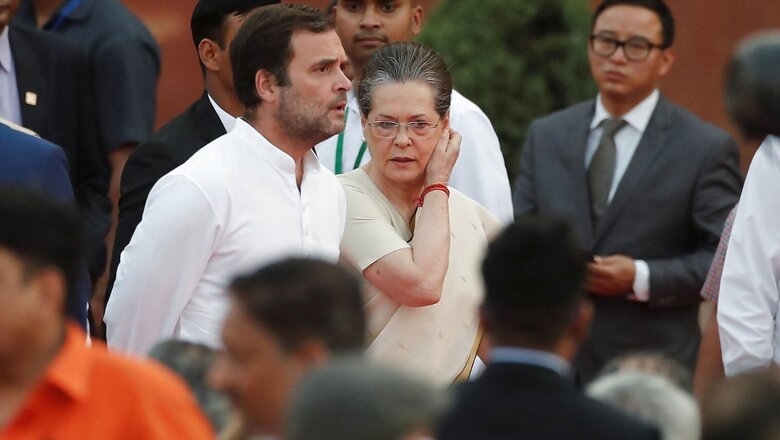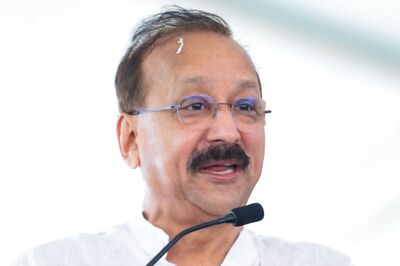
views
After many delays and roadblocks, the election for the Indian National Congress’ presidency is all set to take place this October, almost three years after Sonia Gandhi took over for what was supposed to be an interim tenure. The election has taken centre stage in Indian political discourse, with the Congress further descending into disunity and chaos. Other than one of the two surviving Congress state governments falling in trouble due to this election, there are two important reasons this election is being watched closely.
First, although inapplicable in 2022, this election has shaped India’s political destiny for almost a 100 years. And second, this election is a test to the centrality of the Nehru-Gandhi dynasty within the party, arguably the party’s quintessential characteristic.
The centrality of this dynasty, which became a feature of Indian politics and government for decades, also has its origins in the election for the Indian National Congress president. To better understand what is at stake and how this election shaped India’s destiny, especially with regards to the dynasty, it is important to walk down memory lane.
The Indian National Congress was founded by Allan Octavian Hume in 1885, a British administrator who had first-hand experience of the revolt in 1857 and wanted to prevent such occurrences in the future. Initially, the Congress started out as a channel of communication between the ruler and the ruled, namely the British Empire and the Indians. As Hume’s biographer noted, “And it is to limit and control them and direct them when there is yet time to do so… that this Congress movement was designed”.
For years, the Congress would not seek independence from the British, pledging unconditional allegiance to the crown while making modest demands such as allowing Indians to hold high offices in the administration. This is why the party was, in its initial decades, made up of Indian elites who hobnobbed with the British. It is also the reason those seeking complete independence would clash with the party establishment and make attempts to take over the party at regular intervals, until the party itself changed course and finally sought for independence from the British.
Motilal Nehru was the son of Gangadhar Nehru, the Kotwal (chief of police) of the last Mughal emperor of India, Bahadur Shah Zafar. Motilal passed the bar exam in 1883 and began practicing, until he inherited a lucrative law firm that his brother was running upon the latter’s demise. Thereafter, he became among the most high-profile lawyers in British India, visiting England frequently, hosting British officials in his Allahabad mansion, and even getting permission to appear before the judicial committee of the Privy Council in Britain. In 1918, Motilal met Mahatma Gandhi and became his follower immediately, pledging to avoid Western goods and adopt a more Indian lifestyle. The following year, at the Indian National Congress’ 1919 session, Motilal was elected president.
In 1928, at the Calcutta session of the Indian National Congress, Motilal was elected president once again. The following year, at the 1929 session, his own son Jawaharlal succeeded him as president. Journalist Durga Das, who covered the Congress and the freedom struggle closely, wrote about the Lahore session: “The provincial committees had recommended Gandhi and Sardar Vallabhai Patel for the president-ship of the Congress. Gandhi, who had resumed the party’s active leadership at the previous session, was expected to welcome the nomination of the hero of Bardoli (Patel), his most dependable lieutenant. When Gandhi announced his preference for Jawaharlal, the general body of Congressmen, especially the senior leaders who felt they had been superseded, were astonished. For one thing, it was considered odd that a son should succeed his father to the Congress throne, and for another there was regret that Sardar Patel’s outstanding services had been overlooked.”
Durga Das then went to Gandhi and sought his version of the events for this last-minute surprise. He writes, “The Mahatma pointed out that Motilal had repeated with greater emphasis the argument put forward in his letter of July 1928 that Jawaharlal represented youth and dynamism. He had agreed with Motilal, and the choice was particularly appropriate when the Congress was about to launch a fresh struggle. He added that Sardar Patel would be with him in any case…” According to Rajmohan Gandhi’s book The Good Boatman, it wasn’t Motilal’s letter and argument alone, but Jawaharlal’s mother Swarup Rani too, who had reached out to Gandhi and pushed Jawaharlal’s name for the presidency. Gandhi succumbed, the story goes, due to the display of motherly love.
Although the 1929 election laid the foundation for this dynasty within the Congress, Nehru would go on to edge Sardar Patel out due to the Mahatma’s backing again, first at the 1937 session, and finally at the 1946 session. The 1946 presidential elections would set the stage for the dynasty to establish itself at the helm of the Indian republic as well.
That year, due to the Second World War and many senior Congress leaders being imprisoned due to the Quit India movement, the presidential election of the Congress was taking place for the first time after 1940. The war was coming to an end, therefore independence from the British was slated to be right around the corner. With the Congress Party having maximum seats in the Central Assembly, its president would be invited to form the government. Therefore the 1946 election to the Congress presidency was, in other words, the election for independent India’s first leader.
Gandhi threw his weight behind Jawaharlal Nehru for this election, but technically, only the state committees could nominate anyone for the post. According to Professor Makkhan Lal, the Congress Party’s internal documents indicate that despite Gandhi making his preference clear, 12 of the 15 state committees nominated Sardar Patel, while three abstained. It was then that certain working committee members of the Congress, who had no say in the elections, began persuading Patel to withdraw from the race since Gandhi had made his choice clear.
Gandhi meanwhile, hoping to find a solution, informed Nehru personally that no state committee had nominated him. This was met by complete silence from Nehru, and Gandhi was later informed that Nehru would not accept the second place. Gandhi then asked Patel to withdraw, and his loyal lieutenant obeyed immediately. Thus Nehru became the Congress President, and the first Prime Minister of India. Rajendra Prasad famously remarked that Gandhi had sacrificed his trusted lieutenant for the “glamorous Nehru” once again, adding that Nehru would “follow the British ways”.
After independence, the dynasty got a new lease of life in 1959, and once again it was courtesy a Congress presidential election. Jawaharlal’s daughter Indira Gandhi had been her father’s official hostess and unofficial personal assistant after he took over as Prime Minister. In 1959, the outgoing president of the Congress Party UN Dhebar suggested that Indira succeed him as the party’s president. Soon, several Congress leaders threw their weight behind Indira.
The January issue of Swarajya magazine that year documents her elevation. “The Chief Ministers of Madras and Andhra and the ex-Chief Minister of Mysore issued a press release canvassing support for the Prime Minister’s daughter; the former President of the Andhra Pradesh Congress Committee and now one of the General Secretaries of the Congress advanced special reasons for the choice. More will come forward in the next few days pleading for an uncontested election. No other name is likely to be proposed,” the article says. Further down, the article goes on: “It was a record that Pandit Motilal Nehru handed the Congress crown directly to his son in 1929; it was yet another record that Shri Jawaharlal Nehru presided over five Congress sessions; it will be one more record that the third generation in the same family will annex the presidential gaddi by a popular vote.”
Dehradun’s Member of Parliament Mahavir Tyagi, a senior Congress leader of the time, led the charge against Indira’s elevation. He wrote a stinging letter to Nehru. “Just as in the days of the Mughals, ministers would play with the Nawab’s children, today you are being worshiped, your worshippers have put up bholi-bhali Indu’s name for the post of the Congress president. And perhaps you have accepted it without blinking an eye,” he wrote. He added, “Please don’t be under the misapprehension that this lining up of supporters for the proposal to put up Indu’s name is entirely due to the force of her personality. It is being done hundred percent to please you.”
Nehru replied the next day, “I gave a good deal of thought to this matter and I came to the conclusion that I should firmly keep apart from this business and try not to influence it in any way, except rather generally and broadly to say that it had disadvantages… normally speaking, it is not a good thing for my daughter to come in as Congress President when I am Prime Minister.”
Indira, however, graciously accepted the post. She became the only Congress president between 1951 and 1969 to serve without having been a Chief Minister first. Being a former Congress President and an outspoken Union Minister in Lal Bahadur Shastri’s cabinet thereafter made her one of the frontrunners for the top job upon his death.
It is here that things get interesting because Indira Gandhi, being a sitting Prime Minister, was suspended from the Indian National Congress in 1969. She formed the Indian National Congress (Requisionists) or Congress (R). The original INC became the Indian National Congress (Organisation) or Congress (O), and would go on to merge with the Janata Party. Indira’s Congress (R) became Congress (I) in the seventies, the ‘I’ standing for her own name. It was in 1981 that the Congress (I) managed to get recognised as the Indian National Congress again, and only in 1996 would the party drop the (I). Therefore, the Indian National Congress as we know it today is a direct creation of Indira Gandhi, and not the same party that existed during the freedom struggle.
Most analysis refrains from making this distinction for practical purposes, because it was the Indira faction that retained relevance and vote-share upon the party’s split. With the party being stamped with Indira’s name later, analysing how different members of the dynasty rose the ranks and captured power is moot, since the party openly transitioned into a personality cult with little regard to merit or procedure.
For example, according to precedent, the senior-most minister of the Union Cabinet would take over if a sitting Prime Minister died, until a new leader was elected. Upon both Nehru and Shastri’s deaths, it was Gulzarilal Nanda who had taken over as interim Prime Minister before new leaders were selected. However, upon Indira Gandhi’s death, her son and first-time MP Rajiv Gandhi superseded the then senior-most minister Pranab Mukherjee to the post. Upon Rajiv’s death in 1991, many senior leaders approached his widow Sonia to take over the party because they simply assumed that the crown would be passed to someone in the family, but she remained reluctant. Notwithstanding the split of 1969 and a short hiatus between 1964 and 1966, for the first time since independence, the dynasty was left out of both the prime ministership and the Congress presidency.
The dynasty made an incredible comeback in 1998, with Sonia becoming the Congress President. Sonia’s election was quite different from earlier elections, and arguably, would not qualify as an election per say. Sonia had made a grand entry into the Congress the previous year and served as its star campaigner for the Lok Sabha elections. Ever since, the top brass of the party was pressurising then president Sitaram Kesri to vacate his post for her. The drubbing that the party received in the elections strengthened the top brass’ case to oust Kesri, although the tottering 80-year-old held on to his post. Kesri argued he had been elected to the post legitimately by the All India Congress Committee (AICC) and that only the AICC could decide his fate. The top brass, Kesri believed, could not force him out of his post before the end of his tenure.
Thereafter, a Congress Working Committee (CWC) meeting was called. Some members of the CWC met separately hours before the meeting, and passed two resolutions. The first asked Kesri to step down, and the second asked Sonia to replace him. When Kesri arrived for the CWC, Pranab Mukherjee began reading out the resolution thanking Kesri for his services and invoking a clause in the party’s constitution that allowed the CWC to act beyond its mandate in special situations as long as it got the decision ratified by the AICC within six months. In hindsight, observers have called the clause’s usage to remove a president as a creative interpretation, but that is beyond the scope of this article. What is notable is that barring one member, the entire CWC was on board with the move. Kesri called their bluff immediately, adjourned the meeting and left the room in a huff. He made his way to his chamber.
After Kesri entered his chamber, party functionaries locked it from outside. There are other versions to the story as well. According to one version, it was a bathroom that they locked him in. One Navbharat Times report also claims that he was manhandled by Youth Congress workers. The vice-president of the party, however, simply reconvened the same meeting. Soon, Sonia Gandhi walked into the Congress headquarters. Crackers were burst, and slogans congratulating the new president filled the air. When Kesri was let out, the nameplate outside his chamber had already been removed. Journalist Rashid Kidwai writes that it had been replaced with a computer printout which read “Congress president Sonia Gandhi”.
Sonia Gandhi went on to become the longest-serving president of the Congress party. She served uninterrupted from 1998 to 2017. After formally winning the elections in 1999, the CWC, which was earlier elected by the AICC, empowered her to choose her own CWC. This practice continued till 2017, when her son Rahul Gandhi replaced her as president. For him too, the CWC extended the same courtesy. Sonia returned to head the party in 2019, and her term as interim president lasted longer than the elected tenure of most Congress presidents. The post has been occupied by the mother and son from 1997 till date, at a time when the Congress is facing its worst-ever crisis.
It is in this context that the Congress presidential elections are being watched keenly. The dynasty will have to make compromises, for they are now left with little choice. At the same time, the party is past the point of being able to function without the dynasty. As an important dynasty and a party enter the last legs of their respective journeys, it is perhaps time to add them to our history books, analyse how they came about, how they entrenched themselves, how they shaped our destiny, and how they gradually faded away into oblivion. The ongoing presidential election serves as an indicator that the curtains are closing.
Read all the Latest Opinion News and Breaking News here
















Comments
0 comment